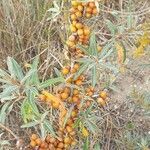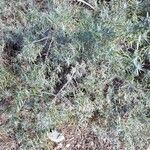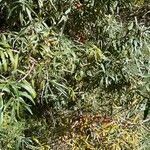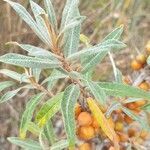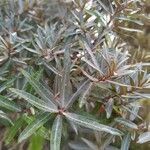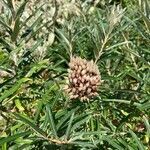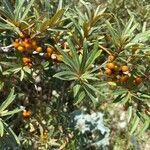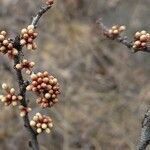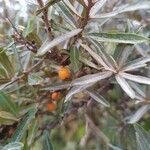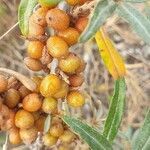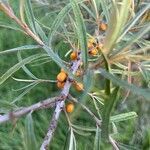Shrubs or trees, 1-15(-18) m tall. Bark brownish green, yellowish brown, or black; branches many, spines 2-7 cm. Leaves alternate; petiole ± absent; leaf blade abaxially silvery white suffused with brown or yellow, adaxially dark grayish green, linear or linear-lanceolate, 2-8 × 0.2-0.8 cm, ± narrowed at base, abaxially with white and brown stellate scales, margin ± revolute, apex subobtuse. Male inflorescence a minute spike, 5-8 × 4-6 mm. Male flowers: calyx lobes greenish brown, ovate-orbicular, 3-4 × 3-3.5 mm, concave, outside with numerous brown and sparse white stellate scales; stamens 1/2-2/3 as long as calyx; anthers nearly sessile, oblong-linear, ca. 1.5 mm. Female flowers 2-5 in axils of branchlets; pedicels ca. 0.5 mm, to 5 mm in fruit; calyx brown, tubular, oblong-obovate, 2.5-4 × 1-1.5 mm, outside with stellate brown and few white scales, lobes obtuse, interior with rather long white hairs, dense in upper part; Ovary globose-ovoid, 1-2 mm, ca. 1/2 as long as calyx, glabrous; style ca. 0.5 mm; stigma oblong, 0.5-1 mm, exserted. Peduncle 1-7 mm. Fruit orange or reddish, globose, ovoid, globose-ovoid, or ellipsoid, terete, 4-9(-10) × 3-8 mm, glabrous, succulent and aromatic. Endocarp easy to separate from seed. Seed dark brown, sometimes nearly black, glossy, ovoid-oblong, or oblong-ellipsoid, 4-7 × 1.5-2 or 4-5 mm. Fl. Apr-May, fr. Sep-Oct. 2n = 24*.
More
A shrub or small tree which loses its leaves. It grows to 6 m high. It has a bushy arching habit. The twigs often become thorns. The leaves are alternate and without teeth. The leaves are very narrow and grey-green. They are paler underneath. They are 7.5 cm long. They have short stalks and droop from spiny twigs. Male and female flowers grow on separate bushes. The flowers are small and yellow or green. They grow in clusters. They appear before the leaves. The fruit are bright orange berries. They occur in dense clusters on the shoots of female plants. Both male and female plants must be grown together to get fruit. The fruit are edible. Now probably Elaeagnus rhamnoides
It is a temperate plant. It is native to Asia and Europe. It grows near the coast and along riverbanks and in sandy woods. A cool climate plant. They are salt resistant. It needs plenty of light. It grows by the sea. It can tolerate drought. In the Indian Himalayas it grows between 3,300-4,000 m above sea level. It suits hardiness zones 2-9. In Sichuan and Yunnan.
More
Usually found near the coast, often forming thickets on fixed dunes and sea cliffs. River banks and terraces, dry river beds, forest margins, thickets on mountain slopes, moraines, meadows at highest elevations; 600-4,200 metres.
The fruit are made into preserves and pickles. They are acid tasting. They are also eaten with milk and cheese or made into sauces, jams, marmalade, syrup and jelly. They are also eaten raw. The fruit are used for juice.
